the 180mag
editor's blog
"Anyone who listens to an artist needs their eyes examined" -Claus Oldenburg
"Anyone who listens to an artist needs their eyes examined" -Claus Oldenburg
send us an email
You can track this page with firefox add-ons
| current
issue submissions contact archive 180 studio 180 forum |
Cool Links |
my soundtrack: folkradio.co.uk Kim Taylor my workshops: 180 photo workshops |
blog
archive
|
Figuring I should write another blog entry while I've got a few minutes, I just went through about 30 photography blogs.
I came up with nothing. Not a single drop of inspiration.
This is what I saw:
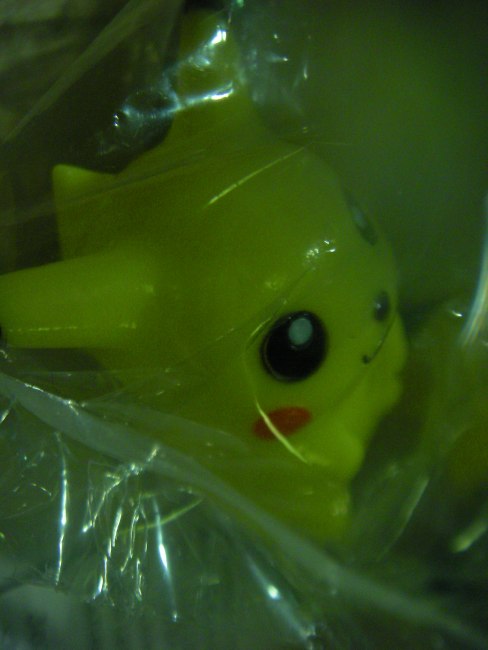
PIKA! by Kim Taylor, Sept 17, 2008
It's what I've absorbed from the contemporary art photography world in the blogosphere, what I automatically create when I decide to "do a little art".
Let's see, this shot takes the childhood of my kids, mixes in the mass-produced commercialism of modern society, adds the vanitas of the plastic bag over the head and is shot in the snot green that represents the sickness of our modern souls.
Not to mention that I leaned over, grabbed the bag of toys from a box, leaned over the other way and grabbed the point and shoot, and got it all done in 30 seconds without getting up from my desk. In other words, "automatic art", straight from the unconscious.
I'm perfectly serious about all that by the way, I took over 30 shots of those toys in their plastic bags so I meant what I was doing.
A few weeks earlier I took this shot:
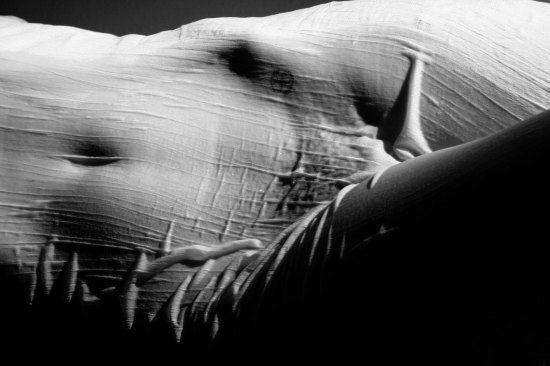
"For Erwin" by Kim Taylor, July 6, 2008
I don't see this sort of work in
today's contemporary art blogs, or anywhere else for that matter. For
one thing it's been done, it's about Erwin Blumenfeld's wet silk
photographs from 1936. Art today isn't about referencing the past, it's
about getting as far away from the past as possible. That's why every
portrait is taken at dead center. Serious artists and your Aunt Mabel
take portraits dead centre. Your aunt because that's where the focus
spot is, and serious artists because that's where your aunt takes them.
That is, every photography manual in the world tells you to get the
head out of the centre of the shot... so every serious artist in the
world centers that head.
Art since the '50s has been about "challenging authority", about "breaking down the barriers" and it's all quite standardized now. Everyone agrees on what proper art is, it's as standardized as any wedding photography or seniors portrait studio. We know what to expect in the gallery and the museum and we don't want to be disappointed.
I don't really think about this stuff when I'm working, but I do find that when I'm not "doing art" I drift toward the photography of the '20s and '30s. When I "do art" I get a bit of a lopsided grin on my face and start writing statements in my head.
Of course I have no idea what that means, it's just something I've noticed.
Art since the '50s has been about "challenging authority", about "breaking down the barriers" and it's all quite standardized now. Everyone agrees on what proper art is, it's as standardized as any wedding photography or seniors portrait studio. We know what to expect in the gallery and the museum and we don't want to be disappointed.
I don't really think about this stuff when I'm working, but I do find that when I'm not "doing art" I drift toward the photography of the '20s and '30s. When I "do art" I get a bit of a lopsided grin on my face and start writing statements in my head.
Of course I have no idea what that means, it's just something I've noticed.
Did a fashion shoot over the weekend. First one in quite a while, and it was good to get back into it. Set up a couple of sets and Alena the stylist started throwing models at me so I had to keep playing with the lights and the sets to find something new each time. I should have shot a photo of the overall setup but wasn't thinking about a blog entry.
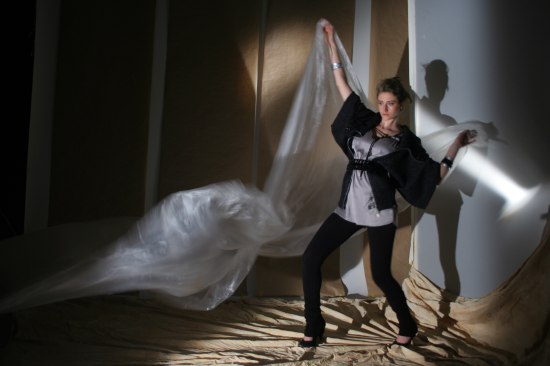
I can spot a lot of my figure work in these shots, there are my light streaks across the backdrop, and there's Leta with my plastic dropsheet. This was the last setup and I more or less went back to the beginning setup except that I tore down a dropsheet and changed the shooting angle.
It's such a luxury to shoot in a big studio with lots of open space.
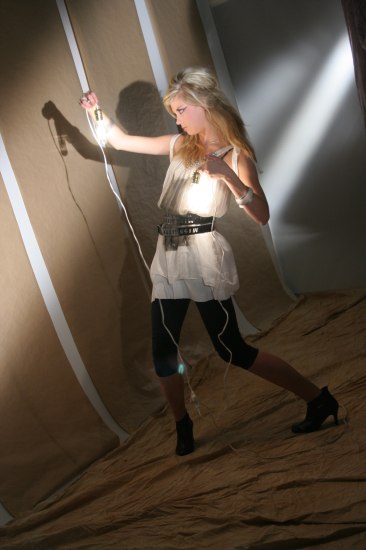
We started out with my little lightbulbs as our "theme" a dark sort of idea that we may look at in black and white.
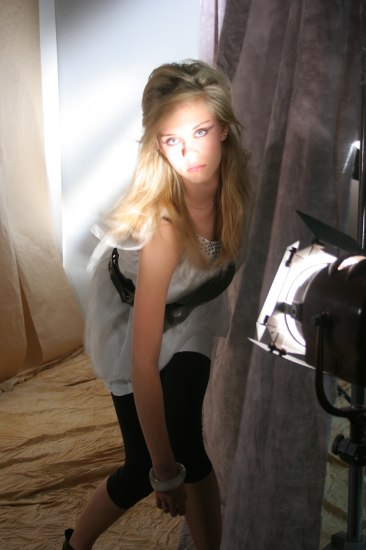
A couple of bulbs and a couple of fresnel hot-lights were all we used for lighting. I get way too confused with too many lights around. You can see a third little fresnel in this shot, it blew shortly after this and I didn't stop to see if we had another bulb.
Anybody who thinks that Sam's face is blown out, download the shot and convert it to black and white. If you still think it's blown out.... fine. Me, I like it but I grew up in the '60s when pots and fresnels ruled the land and softboxes were just umbrellas.
Shooting with the hot-lights means I can shoot slow, around 1/10 second to 1/50 at iso400 so I can get my soft looks with the occasional blur. A lot easier on the retouching time since this light is hard hard hard. Check out the sharpness of the shadows in the other shots, that's what a fresnel does.
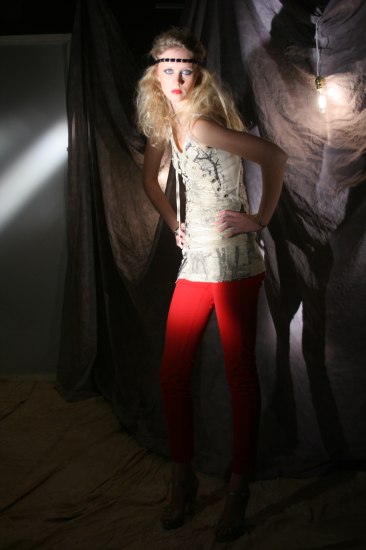
I swung everything over onto the dropcloth to the right for this shot of Lauren, again keeping our little bulbs burning. That streak in the background is a diffusion panel with a light behind it.
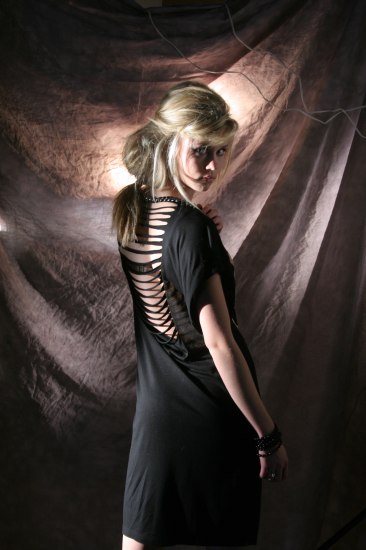
By this time, bright light that I myself am, I realized we were channeling the '80s and I started to get a disco headache even though we were playing indie-folk. We moved to the other side of the dropcloth, let the little bulbs shine through the cloth and Sam gave me a nice '80s pose to show off the back of this dress.
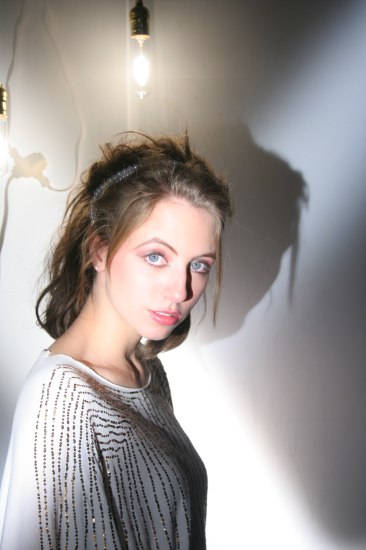
Getting tired of the fabric I swung the diffusion panel out so I could use it and strung the bulbs over it, put a light behind to chop up shadows, and give one for the octopus behind, then used the other hot-light to throw a shadow on the unlit part of the panel. Caught Meredith in the cross-fire. The streaks are made by using the barn doors on the lights.
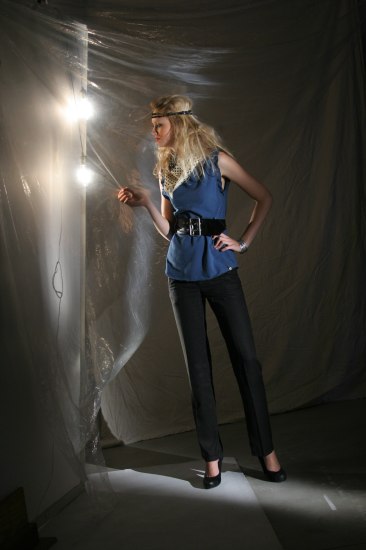
Moving once more to the right I hit my second setup, a dropcloth and a plastic sheet hung from a bar. I attached the plastic sheet to the diffusion panel and Lauren was in a pretty harsh background. Amazingly enough we didn't melt the plastic all over the bulbs. That back-light on Lauren isn't from the puny little bulbs, it's from the second hot-light aimed right back at the first through the gap between the diffusion panel and the dropcloth.
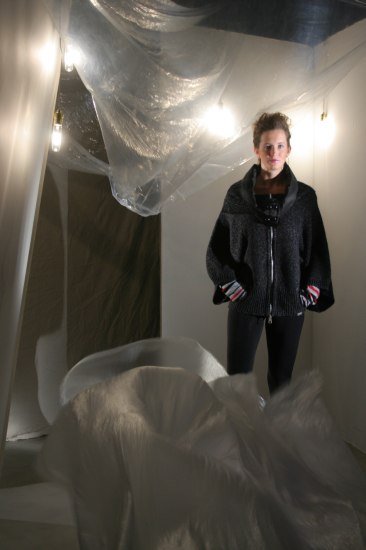
Finally moved all the way right to the edge of the second set and shot into the corner where I'd put a folding panel and dropped the bulbs over it. The nice poofy stuff at Amanda's feet is a plastic drop-cloth taped to a fan. It's my metaphorical snow-field since she's wearing a coat and mittens.
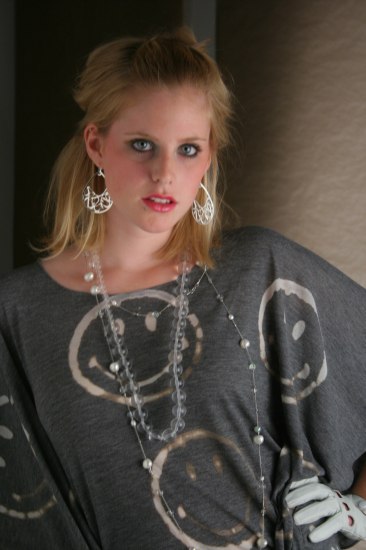
The softest light of the day, a hotlight through the diffusion panel and a bounce card on the other side. Amy was along to keep another model company but we dragged her into the shoot too. This is where I tore down the dropcloth to shoot on the paper columns again.
Now you've got all my secrets. Work it out on the nudes where you have lots of time to look and think, then move on instinct when you've got a studio full of people working hard. Nobody's got an inborn ability for this stuff, it's all from long practice and hard looking. Instinct is experience un-hindered by rational thought.
The better the photographer, the more personal work, at least from what I've seen.
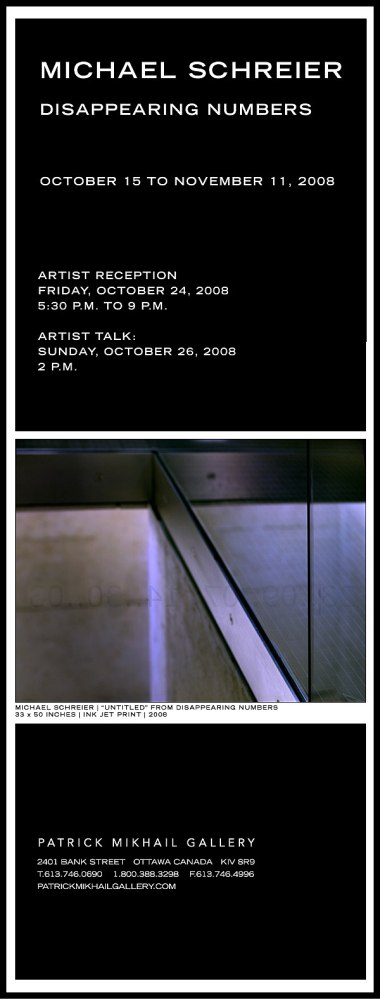
OTTAWA, OCTOBER 15, 2008…PATRICK MIKHAIL GALLERY is pleased to present DISAPPEARING NUMBERS, an exhibition featuring new work from Ottawa photo-based artist Michael Schreier. The images, most recently previewed at the 2008 Toronto International Art Fair, are part of Mr. Schreier’s second solo exhibition with the gallery.
In DISAPPEARING NUMBERS, Mr. Schreier presents a selection of large-format photographs from a recently completed, limited-edition book, entitled Storyteller/Waiting for Words, which focuses on transitional spaces, energized by light. Within these spaces, an event, underscored by disappearing numbers, a time-line to the instant of exposure, offers a visual metaphor to a moment lost. With faith one might return to memory and the inspired recovery of voice. Within this rich atmosphere of reflection and tender muse, consistent with previous work, Mr. Schreier proposes that one approach these interior images with a reverence for one’s private experience, for as Emily Falvey suggests in her epilogue to Storyteller/Waiting for Words:
“…without taking a moment to quietly realize the limits of material existence, reason turns to madness and imagination becomes its slave…”
Mr. Schreier’s work is represented in public and private collections, including the National Gallery of Canada, the Canadian Museum of Contemporary Photography, the Ottawa Art Gallery, Canada Council Art Bank, the National
Archives Photography Collection, the Agnes-Etherington Art Centre, Canadian Portrait Gallery, Visual Studies Workshop, (Rochester, New York), Light Work Co-Operative, (Syracuse, New York), Carleton University Art Gallery, and the University of Ottawa Library Special Collections. He has a Diploma in Photographic Arts from Toronto’s Ryerson Polytechnical Institute (Ryerson University), and a Master of Fine Arts from Concordia University in Montreal. He was most recently an Associate Professor in the Visual Arts Department at the University of Ottawa.
PATRICK MIKHAIL GALLERY
2401 Bank Street
Ottawa Canada K1V 8R9
Tel. 613.746.0690 TF: 1.800.388.3298
E-mail: gallery@patrickmikhailgallery.com
Web: www.patrickmikhailgallery.com
News
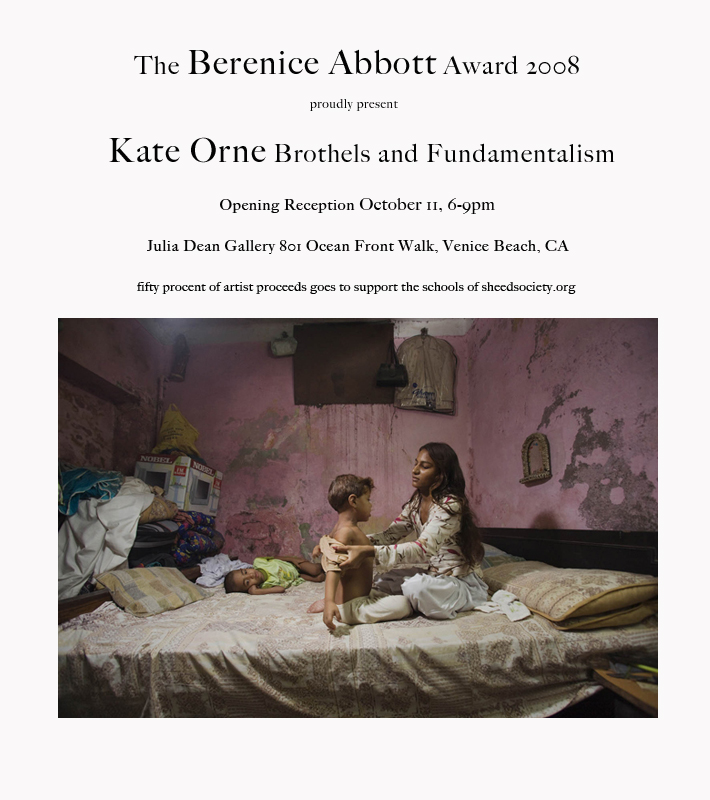
Oct 8, 2008
Here's a shot we did a few days ago, we grabbed LED lights, plastic, mirrors, a couple boxes and a plastic modifier and threw them all onto the stage.
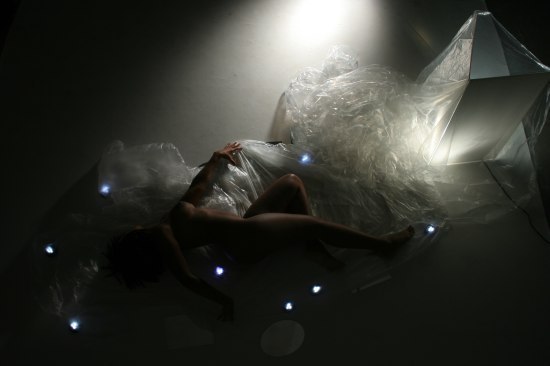
Clutter and Confusion
Looking through the shots it was all too much and we soon booted most of the stuff off to the side.
But I kept getting pulled into the thumbnails, in a tiny shot with my glasses off I keep seeing something interesting. On the theory that you can actually see too much in a photograph, or too clearly, I took the above shot into Irfanview (a program I highly recommend) and applied a photoshop gradient blur plugin.
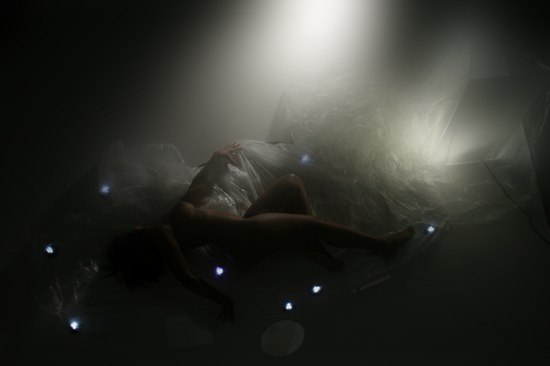
Stars and Galaxies
This is heading in the right direction, some specific blurring, a bit of burning, a tiny gamma adjustment maybe and you'll have something worth looking at.
It's often useful to look at the thumbnails of your shots, or at least to step back and squint to see the composition. While the shot may be cluttered and useless in our super-sharp autofocus world, some good old-fashioned mystery blur and grain can do wonders.
Here's what we came up with later when we booted everything but the mirrors out of our lives.
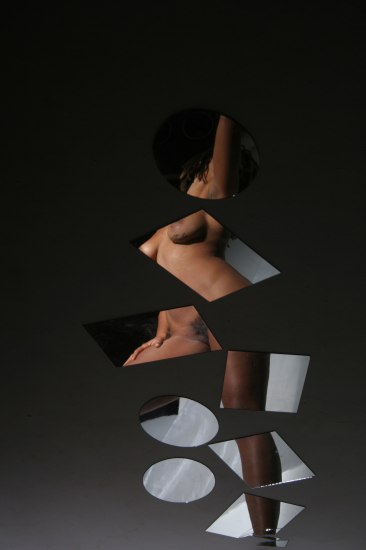
Shattered
I know I say this a lot but damn, I'm just so impressed with the models that work with me. This morning at dawn it was not far from freezing and there we were at the river. I was fine, had a vest and a hoodie on, socks and shoes, long pants. Aside from a slight hangover I was pretty comfortable with a tummy full of oatmeal and nice pockets to warm up my fingers when I wanted to.
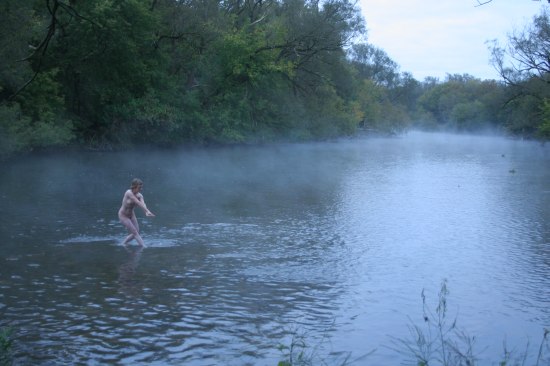
Yep, straight from the camera, isn't automation wonderful.
Was pretty out there, mist on the water, the sun threatening to come out but of course it didn't until we got back to the car and were heading for coffee. Just checked the time and this was 8 minutes after sunrise, with a temperature of 4c. Refreshing.
